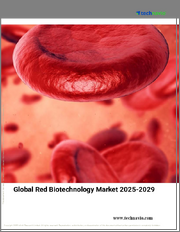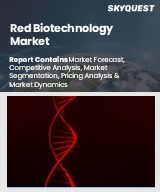
|
시장보고서
상품코드
1790417
레드 바이오테크놀러지 시장 규모, 점유율, 동향 분석 보고서 : 제품별, 최종 용도별, 지역별, 부문별 예측(2025-2030년)Red Biotechnology Market Size, Share & Trends Analysis Report By Product, By End Use (Academic Research Institutes, CMOs & CROs, Pharmaceutical & Biotechnology Companies, Others), By Region, And Segment Forecasts, 2025 - 2030 |
||||||
레드 바이오 시장 요약
레드 바이오테크놀러지 세계 시장 규모는 2024년 5,465억 9,000만 달러로 추정되며, 2025년부터 2030년까지 연평균 10.5% 성장하여 2030년에는 9,977억 4,000만 달러에 달할 것으로 예측됩니다. 개인 맞춤형 의료에 대한 수요 증가, 생명공학 제품 연구에 대한 높은 투자, 유전자 연구의 발전이 이 분야를 형성하고 있습니다.
레드바이오테크놀러지는 줄기세포, 유전자 치료, 유전공학, 신약 및 백신 개발 등 생명공학 응용을 다룹니다. 레드 바이오테크놀러지는 의료를 개선하고 질병과 싸우는 신체를 돕기 위해 생물을 이용하는 과정입니다. 의료 분야에서 사용되는 현대 기술의 일부입니다. 인간의 고통을 완화하고 삶의 질을 향상시킬 수 있기 때문에 제약 산업과 의료 분야에서 응용되고 있습니다. 생물학적 의약품을 제조하기 위해 유전공학의 활용이 증가하고 있는 것은 주요 트렌드 중 하나입니다. 여기에는 치료용 항체와 같은 특정 단백질을 대량으로 생산할 수 있는 유전자 변형 생물을 생산하기 위해 재조합 DNA 기술을 사용하는 것이 포함됩니다.
이 시장은 예측 기간 동안 유리한 성장을 이룰 것으로 예측됩니다. 급성 미생물 감염을 치료하는 항생제부터 에이즈 관리에 도움이 되는 아지드티미딘을 포함한 항 HIV/AIDS와 같은 만성 질환에 이르기까지 질병 관리에 큰 진전을 이루었습니다. 많은 제약회사들이 당뇨병, 알츠하이머병, 파킨슨병 등 신경질환에 대한 파이프라인 제품을 개발 및 생산하고 있습니다. clinicaltrials.gov에 따르면 2021년 1월 현재 알츠하이머병 치료제로 126개의 약물이 임상시험 중이며, 그 중 28개의 약물이 임상 3상 시험 단계에 있습니다. 발효 기술은 생명과학 및 헬스케어 분야에서 널리 사용되고 있으며, 시장 성장에 긍정적인 영향을 미치고 있습니다.
이 시장은 현재도 계속 성장하고 있으며, 의학의 진보를 촉진하고 유전적 요인으로 인한 질병의 식별을 변화시킬 수 있는 큰 잠재력을 가지고 있습니다. 새로운 검사는 질병과 관련된 유전자의 DNA 염기서열 변화를 감지할 수 있으며, 조기 발견은 조기 치료를 통해 질병을 피하거나 진행을 늦추는 데 매우 중요한 요소입니다.
목차
제1장 조사 방법과 범위
제2장 주요 요약
제3장 레드 바이오테크놀러지 시장 변수, 동향, 범위
- 시장 계통 전망
- 상위 시장 전망
- 관련/부수 시장 전망
- 시장 역학
- 시장 성장 촉진요인 분석
- 시장 성장 억제요인 분석
- 레드 바이오테크놀러지 시장 분석 툴
- 업계 분석 - Porter의 Five Forces 분석
- PESTEL 분석
- 레드 바이오테크놀러지 시장 : 파이프라인 분석
제4장 레드 바이오테크놀러지 시장 : 제품 추정·동향 분석
- 제품 부문 대시보드
- 레드 바이오테크놀러지 시장 : 제품 변동 분석
- 세계의 레드 바이오테크놀러지 시장 규모와 동향 분석(제품별, 2018-2030년)
- 단일클론항체
- 다중클론항체
- 재조합 단백질
- 백신
- 세포 기반 면역치료 제품
- 유전자 치료 제품
- 세포치료 제품
- 티슈-엔지니어링 제품
- 줄기세포
- 세포배양
- 바이러스 벡터
- 효소
- 키트 및 시약
- 동물 모델
- 분자진단
- 기타
제5장 레드 바이오테크놀러지 시장 : 최종 용도 추정·동향 분석
- 최종 용도 부문 대시보드
- 레드 바이오테크놀러지 시장 : 최종 용도 변동 분석
- 세계의 레드 바이오테크놀러지 시장 규모와 동향 분석(최종 용도별, 2018-2030년)
- 학술연구기관
- CMO 및 CRO
- 제약 기업 및 바이오테크놀러지 기업
- 기타
제6장 레드 바이오테크놀러지 시장 : 지역 추정·동향 분석
- 지역 시장 대시보드
- 지역별 시장 점유율 분석, 2024년 및 2030년
- 지역별 레드 바이오테크놀러지 시장 : 주요 포인트
- 북미
- 미국
- 캐나다
- 멕시코
- 유럽
- 영국
- 독일
- 프랑스
- 이탈리아
- 스페인
- 노르웨이
- 스웨덴
- 덴마크
- 아시아태평양
- 일본
- 중국
- 인도
- 호주
- 한국
- 태국
- 라틴아메리카
- 브라질
- 아르헨티나
- 중동 및 아프리카
- 남아프리카공화국
- 사우디아라비아
- 아랍에미리트(UAE)
- 쿠웨이트
제7장 경쟁 구도
- 주요 시장 진출기업의 최근 동향과 영향 분석
- 기업/경쟁 분류
- 벤더 구도
- Key company heat map analysis, 2024
- 기업 개요
- Merck KGaA
- F. Hoffmann-La Roche Ltd
- Pfizer Inc.
- Regeneron Pharmaceuticals, Inc.
- AstraZeneca
- Takeda Pharmaceutical Company Limited
- Gilead Sciences, Inc.
- Biogen
- Amgen Inc.
- Celgene Corporation(acquired by Bristol-Myers Squibb Company)
Red Biotechnology Market Summary
The global red biotechnology market size was estimated at USD 546.59 billion in 2024, and is projected to reach USD 997.74 billion by 2030, growing at a CAGR of 10.5% from 2025 to 2030. The increasing demand for personalized medicine, high investment in the R&D of biotechnology products, and advances in genetic research are shaping the field.
Red biotechnology deals with biotechnological applications such as stem cells, gene therapy, genetic engineering, and the development of new drugs and vaccines. Red biotechnology is a process that uses organisms to improve health care and aid the body in fighting diseases. It is a subset of modern technology used in the field of medicine. It finds application in the pharmaceutical industry and the medical sector, as it helps alleviate human suffering and improves the quality of life. The increasing usage of genetic engineering to produce biological medicine is one of the major trends. This includes using recombinant DNA technology to create genetically modified organisms capable of producing large amounts of a specific protein, such as a therapeutic antibody.
The market is expected to witness lucrative growth during the forecast period. It has made significant advancements in disease control, from antibiotics for treating acute microbial infections to chronic conditions such as anti-HIV/AIDS, including azidothymidine, which has helped manage AIDS. Many pharmaceutical companies are developing and manufacturing pipeline products for diabetes and neurological disorders such as Alzheimer's and Parkinson's disease. According to clinicaltrials.gov, 126 agents were in clinical trials for the treatment of Alzheimer's disease as of January 2021, with 28 treatments in phase III trials. Fermentation technology is widely used in the life sciences and healthcare sectors, positively impacting market growth.
The market is still growing, with significant potential for driving medical advancements and transforming the identification of diseases caused by genetic factors. Novel tests can detect changes in the DNA sequence of genes linked to diseases, and early detection is a crucial factor in avoiding disease or slowing its progression through early treatment.
Global Red Biotechnology Market Report Segmentation
This report forecasts revenue growth at global, regional, and country levels and provides an analysis of the latest industry trends in each of the sub-segments from 2018 to 2030. For this study, Grand View Research has segmented the global red biotechnology market report based on product, end-use, and region:
- Product Outlook (Revenue, USD Billion, 2018 - 2030)
- Monoclonal Antibodies
- Polyclonal Antibodies
- Recombinant Proteins
- Vaccines
- Cell-Based Immunotherapy Products
- Gene Therapy Products
- Cell Therapy Products
- Tissue-Engineered Products
- Stem Cells
- Cell Culture
- Viral Vector
- Enzymes
- Kits and Reagents
- Animal models
- Molecular diagnostics
- Others
- End-User Outlook (Revenue, USD Billion, 2018 - 2030)
- Academic Research Institutes
- CMOs & CROs
- Pharmaceutical & Biotechnology Companies
- Others
- Regional Outlook (Revenue, USD Billion, 2018 - 2030)
- North America
- U.S.
- Canada
- Mexico
- Europe
- U.K.
- Germany
- France
- Italy
- Spain
- Denmark
- Sweden
- Norway
- Asia Pacific
- Japan
- China
- India
- South Korea
- Australia
- Thailand
- Latin America
- Brazil
- Argentina
- Middle East & Africa
- South Africa
- Saudi Arabia
- UAE
- Kuwait
Table of Contents
Chapter 1. Methodology and Scope
- 1.1. Market Segmentation & Scope
- 1.2. Segment Definitions
- 1.2.1. Product
- 1.2.2. End Use
- 1.2.3. Regional scope
- 1.2.4. Estimates and forecasts timeline
- 1.3. Research Methodology
- 1.4. Information Procurement
- 1.4.1. Purchased database
- 1.4.2. GVR's internal database
- 1.4.3. Secondary sources
- 1.4.4. Primary research
- 1.4.5. Details of primary research
- 1.5. Information or Data Analysis
- 1.5.1. Data analysis models
- 1.6. Market Formulation & Validation
- 1.7. Model Details
- 1.8. List of Secondary Sources
- 1.9. List of Primary Sources
- 1.10. Objectives
Chapter 2. Executive Summary
- 2.1. Market Outlook
- 2.2. Segment Outlook
- 2.2.1. Product outlook
- 2.2.2. End use outlook
- 2.2.3. Regional outlook
- 2.3. Competitive Insights
Chapter 3. Red Biotechnology Market Variables, Trends & Scope
- 3.1. Market Lineage Outlook
- 3.1.1. Parent market outlook
- 3.1.2. Related/ancillary market outlook
- 3.2. Market Dynamics
- 3.2.1. Market driver analysis
- 3.2.2. Market restraint analysis
- 3.3. Red Biotechnology Market Analysis Tools
- 3.3.1. Industry Analysis - Porter's
- 3.3.1.1. Supplier power
- 3.3.1.2. Buyer power
- 3.3.1.3. Substitution threat
- 3.3.1.4. Threat of new entrant
- 3.3.1.5. Competitive rivalry
- 3.3.2. PESTEL Analysis
- 3.3.2.1. Political landscape
- 3.3.2.2. Technological landscape
- 3.3.2.3. Economic landscape
- 3.3.1. Industry Analysis - Porter's
- 3.4. Red Biotechnology Market: Pipeline Analysis
Chapter 4. Red Biotechnology Market: Product Estimates & Trend Analysis
- 4.1. Product Segment Dashboard
- 4.2. Red Biotechnology Market: Product Movement Analysis
- 4.3. Global Red Biotechnology Market Size & Trend Analysis, by Product, 2018 to 2030 (USD Billion)
- 4.4. Monoclonal Antibodies
- 4.4.1. Market estimates and forecasts 2018 to 2030 (USD Billion)
- 4.5. Polyclonal Antibodies
- 4.5.1. Market estimates and forecasts 2018 to 2030 (USD Billion)
- 4.6. Recombinant Proteins
- 4.6.1. Market estimates and forecasts 2018 to 2030 (USD Billion)
- 4.7. Vaccines
- 4.7.1. Market estimates and forecasts 2018 to 2030 (USD Billion)
- 4.8. Cell-Based Immunotherapy Products
- 4.8.1. Market estimates and forecasts 2018 to 2030 (USD Billion)
- 4.9. Gene Therapy Products
- 4.9.1. Market estimates and forecasts 2018 to 2030 (USD Billion)
- 4.10. Cell Therapy Products
- 4.10.1. Market estimates and forecasts 2018 to 2030 (USD Billion)
- 4.11. Tissue - Engineered Products
- 4.11.1. Market estimates and forecasts 2018 to 2030 (USD Billion)
- 4.12. Stem Cells
- 4.12.1. Market estimates and forecasts 2018 to 2030 (USD Billion)
- 4.13. Cell Culture
- 4.13.1. Market estimates and forecasts 2018 to 2030 (USD Billion)
- 4.14. Viral Vector
- 4.14.1. Market estimates and forecasts 2018 to 2030 (USD Billion)
- 4.15. Enzymes
- 4.15.1. Market estimates and forecasts 2018 to 2030 (USD Billion)
- 4.16. Kits and Reagents
- 4.16.1. Market estimates and forecasts 2018 to 2030 (USD Billion)
- 4.17. Animal Models
- 4.17.1. Market estimates and forecasts 2018 to 2030 (USD Billion)
- 4.18. Molecular Diagnostics
- 4.18.1. Market estimates and forecasts 2018 to 2030 (USD Billion)
- 4.19. Others
- 4.19.1. Market estimates and forecasts 2018 to 2030 (USD Billion)
Chapter 5. Red Biotechnology Market: End Use Estimates & Trend Analysis
- 5.1. End Use Segment Dashboard
- 5.2. Red Biotechnology Market: End Use Movement Analysis
- 5.3. Global Red Biotechnology Market Size & Trend Analysis, by End Use, 2018 to 2030 (USD Billion)
- 5.4. Academic Research Institutes
- 5.4.1. Market estimates and forecasts 2018 to 2030 (USD Billion)
- 5.5. CMOs & CROs
- 5.5.1. Market estimates and forecasts 2018 to 2030 (USD Billion)
- 5.6. Pharmaceutical & Biotechnology Companies
- 5.6.1. Market estimates and forecasts 2018 to 2030 (USD Billion)
- 5.7. Others
- 5.7.1. Market estimates and forecasts 2018 to 2030 (USD Billion)
Chapter 6. Red Biotechnology Market: Regional Estimates & Trend Analysis
- 6.1. Regional Market Dashboard
- 6.2. Regional Market Share Analysis, 2024 & 2030
- 6.3. Red Biotechnology Market by Region: Key Takeaways
- 6.4. North America
- 6.4.1. U.S.
- 6.4.1.1. Key country dynamics
- 6.4.1.2. Regulatory framework/ reimbursement structure
- 6.4.1.3. Competitive scenario
- 6.4.1.4. U.S. market estimates and forecasts 2018 to 2030 (USD Billion)
- 6.4.2. Canada
- 6.4.2.1. Key country dynamics
- 6.4.2.2. Regulatory framework/ reimbursement structure
- 6.4.2.3. Competitive scenario
- 6.4.2.4. Canada market estimates and forecasts 2018 to 2030 (USD Billion)
- 6.4.3. Mexico
- 6.4.3.1. Key country dynamics
- 6.4.3.2. Regulatory framework/ reimbursement structure
- 6.4.3.3. Competitive scenario
- 6.4.3.4. Mexico market estimates and forecasts 2018 to 2030 (USD Billion)
- 6.4.1. U.S.
- 6.5. Europe
- 6.5.1. UK
- 6.5.1.1. Key country dynamics
- 6.5.1.2. Regulatory framework/ reimbursement structure
- 6.5.1.3. Competitive scenario
- 6.5.1.4. UK market estimates and forecasts 2018 to 2030 (USD Billion)
- 6.5.2. Germany
- 6.5.2.1. Key country dynamics
- 6.5.2.2. Regulatory framework/ reimbursement structure
- 6.5.2.3. Competitive scenario
- 6.5.2.4. Germany market estimates and forecasts 2018 to 2030 (USD Billion)
- 6.5.3. France
- 6.5.3.1. Key country dynamics
- 6.5.3.2. Regulatory framework/ reimbursement structure
- 6.5.3.3. Competitive scenario
- 6.5.3.4. France market estimates and forecasts 2018 to 2030 (USD Billion)
- 6.5.4. Italy
- 6.5.4.1. Key country dynamics
- 6.5.4.2. Regulatory framework/ reimbursement structure
- 6.5.4.3. Competitive scenario
- 6.5.4.4. Italy market estimates and forecasts 2018 to 2030 (USD Billion)
- 6.5.5. Spain
- 6.5.5.1. Key country dynamics
- 6.5.5.2. Regulatory framework/ reimbursement structure
- 6.5.5.3. Competitive scenario
- 6.5.5.4. Spain market estimates and forecasts 2018 to 2030 (USD Billion)
- 6.5.6. Norway
- 6.5.6.1. Key country dynamics
- 6.5.6.2. Regulatory framework/ reimbursement structure
- 6.5.6.3. Competitive scenario
- 6.5.6.4. Norway market estimates and forecasts 2018 to 2030 (USD Billion)
- 6.5.7. Sweden
- 6.5.7.1. Key country dynamics
- 6.5.7.2. Regulatory framework/ reimbursement structure
- 6.5.7.3. Competitive scenario
- 6.5.7.4. Sweden market estimates and forecasts 2018 to 2030 (USD Billion)
- 6.5.8. Denmark
- 6.5.8.1. Key country dynamics
- 6.5.8.2. Regulatory framework/ reimbursement structure
- 6.5.8.3. Competitive scenario
- 6.5.8.4. Denmark market estimates and forecasts 2018 to 2030 (USD Billion)
- 6.5.1. UK
- 6.6. Asia Pacific
- 6.6.1. Japan
- 6.6.1.1. Key country dynamics
- 6.6.1.2. Regulatory framework/ reimbursement structure
- 6.6.1.3. Competitive scenario
- 6.6.1.4. Japan market estimates and forecasts 2018 to 2030 (USD Billion)
- 6.6.2. China
- 6.6.2.1. Key country dynamics
- 6.6.2.2. Regulatory framework/ reimbursement structure
- 6.6.2.3. Competitive scenario
- 6.6.2.4. China market estimates and forecasts 2018 to 2030 (USD Billion)
- 6.6.3. India
- 6.6.3.1. Key country dynamics
- 6.6.3.2. Regulatory framework/ reimbursement structure
- 6.6.3.3. Competitive scenario
- 6.6.3.4. India market estimates and forecasts 2018 to 2030 (USD Billion)
- 6.6.4. Australia
- 6.6.4.1. Key country dynamics
- 6.6.4.2. Regulatory framework/ reimbursement structure
- 6.6.4.3. Competitive scenario
- 6.6.4.4. Australia market estimates and forecasts 2018 to 2030 (USD Billion)
- 6.6.5. South Korea
- 6.6.5.1. Key country dynamics
- 6.6.5.2. Regulatory framework/ reimbursement structure
- 6.6.5.3. Competitive scenario
- 6.6.5.4. South Korea market estimates and forecasts 2018 to 2030 (USD Billion)
- 6.6.6. Thailand
- 6.6.6.1. Key country dynamics
- 6.6.6.2. Regulatory framework/ reimbursement structure
- 6.6.6.3. Competitive scenario
- 6.6.6.4. Thailand market estimates and forecasts 2018 to 2030 (USD Billion)
- 6.6.1. Japan
- 6.7. Latin America
- 6.7.1. Brazil
- 6.7.1.1. Key country dynamics
- 6.7.1.2. Regulatory framework/ reimbursement structure
- 6.7.1.3. Competitive scenario
- 6.7.1.4. Brazil market estimates and forecasts 2018 to 2030 (USD Billion)
- 6.7.2. Argentina
- 6.7.2.1. Key country dynamics
- 6.7.2.2. Regulatory framework/ reimbursement structure
- 6.7.2.3. Competitive scenario
- 6.7.2.4. Argentina market estimates and forecasts 2018 to 2030 (USD Billion)
- 6.7.1. Brazil
- 6.8. MEA
- 6.8.1. South Africa
- 6.8.1.1. Key country dynamics
- 6.8.1.2. Regulatory framework/ reimbursement structure
- 6.8.1.3. Competitive scenario
- 6.8.1.4. South Africa market estimates and forecasts 2018 to 2030 (USD Billion)
- 6.8.2. Saudi Arabia
- 6.8.2.1. Key country dynamics
- 6.8.2.2. Regulatory framework/ reimbursement structure
- 6.8.2.3. Competitive scenario
- 6.8.2.4. Saudi Arabia market estimates and forecasts 2018 to 2030 (USD Billion)
- 6.8.3. UAE
- 6.8.3.1. Key country dynamics
- 6.8.3.2. Regulatory framework/ reimbursement structure
- 6.8.3.3. Competitive scenario
- 6.8.3.4. UAE market estimates and forecasts 2018 to 2030 (USD Billion)
- 6.8.4. Kuwait
- 6.8.4.1. Key country dynamics
- 6.8.4.2. Regulatory framework/ reimbursement structure
- 6.8.4.3. Competitive scenario
- 6.8.4.4. Kuwait market estimates and forecasts 2018 to 2030 (USD Billion)
- 6.8.1. South Africa
Chapter 7. Competitive Landscape
- 7.1. Recent Developments & Impact Analysis, By Key Market Participants
- 7.2. Company/Competition Categorization
- 7.3. Vendor Landscape
- 7.3.1. Key company heat map analysis, 2024
- 7.4. Company Profiles
- 7.4.1. Merck KGaA
- 7.4.1.1. Company overview
- 7.4.1.2. Financial performance
- 7.4.1.3. Product benchmarking
- 7.4.1.4. Strategic initiatives
- 7.4.2. F. Hoffmann-La Roche Ltd
- 7.4.2.1. Company overview
- 7.4.2.2. Financial performance
- 7.4.2.3. Product benchmarking
- 7.4.2.4. Strategic initiatives
- 7.4.3. Pfizer Inc.
- 7.4.3.1. Company overview
- 7.4.3.2. Financial performance
- 7.4.3.3. Product benchmarking
- 7.4.3.4. Strategic initiatives
- 7.4.4. Regeneron Pharmaceuticals, Inc.
- 7.4.4.1. Company overview
- 7.4.4.2. Financial performance
- 7.4.4.3. Product benchmarking
- 7.4.4.4. Strategic initiatives
- 7.4.5. AstraZeneca
- 7.4.5.1. Company overview
- 7.4.5.2. Financial performance
- 7.4.5.3. Product benchmarking
- 7.4.5.4. Strategic initiatives
- 7.4.6. Takeda Pharmaceutical Company Limited
- 7.4.6.1. Company overview
- 7.4.6.2. Financial performance
- 7.4.6.3. Product benchmarking
- 7.4.6.4. Strategic initiatives
- 7.4.7. Gilead Sciences, Inc.
- 7.4.7.1. Company overview
- 7.4.7.2. Financial performance
- 7.4.7.3. Product benchmarking
- 7.4.7.4. Strategic initiatives
- 7.4.8. Biogen
- 7.4.8.1. Company overview
- 7.4.8.2. Financial performance
- 7.4.8.3. Product benchmarking
- 7.4.8.4. Strategic initiatives
- 7.4.9. Amgen Inc.
- 7.4.9.1. Company overview
- 7.4.9.2. Financial performance
- 7.4.9.3. Product benchmarking
- 7.4.9.4. Strategic initiatives
- 7.4.10. Celgene Corporation (acquired by Bristol-Myers Squibb Company)
- 7.4.10.1. Company overview
- 7.4.10.2. Financial performance
- 7.4.10.3. Product benchmarking
- 7.4.10.4. Strategic initiativesa
- 7.4.1. Merck KGaA
(주말 및 공휴일 제외)


















